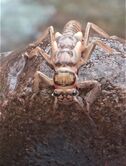CONSERVATION CORNER
A weekly blog for all things conservation
 By: Tori Bristol, Dirt Gravel & Low Volume Roads Specialist As we all know, clean water is vital for maintaining healthy aquatic habitats. As areas start to become more developed, the impacts can be seen on the water quality of freshwater ecosystems. There are many ways to evaluate the health of our streams through chemical, physical and biological assessments. One of the easiest ways that scientists (or even you at home) can judge the health of a stream is to collect Benthic Macroinvertebrates, aka Macros. Benthic macroinvertebrates are valuable indicator species in freshwater streams and rivers. As the name suggests, “Benthic” = they live along the stream bottom, “macro” = are large enough to be seen without a microscope, and “invertebrate” = they don’t have a backbone. These organisms live most, if not all, of their lives in the water. Unlike fish, they are relatively immobile and cannot escape from the effects of pollution. In the field, macros are relatively easy to collect using dip nets and kick nets and are considered a “canary in a coalmine” for water pollution.
Macros are classified into three groups based on the amount of pollution they can withstand. The first group are organisms that cannot survive in water with any kind of pollution (intolerant). These include: Mayfly nymphs, Stonefly nymphs, Caddisfly larvae, Water pennies and Riffle Beetle adults. They require the cleanest water for survival as well as high levels of dissolved oxygen. In particular, mayflies, stoneflies and caddisflies are the most sensitive to changes in water quality. If you find these critters in a stream then it most likely is in good shape! The second group are able to withstand moderate water pollution such as low dissolved oxygen levels or small amounts of nutrient pollution (facultative). Included in this group are: Dragonfly nymphs, Alderfly larvae, Crane fly larvae, Aquatic sowbugs, Crayfish and Freshwater clams and mussels. The third group can handle higher levels of certain types of pollution (tolerant). These include: Blackfly larvae, Midge larvae, Leeches, Aquatic worms and Lunged snails. They can survive in areas with poor water quality and low dissolved oxygen levels. Macroinvertebrates are commonly used to analyze the health of freshwater streams. This includes collecting a sample of macroinvertebrates and counting the various species found. A numerical value is calculated to provide a condition (Excellent, Good, Fair, or Poor) to describe the health of the stream. Streams with excellent water quality will have macroinvertebrates present from all three groups. Severely impacted streams will only have pollution tolerant macroinvertebrates. In addition to their use as bio-indicators, macroinvertebrates are also important components of the stream food web. They are sorted according to their primary food source as shredders, collectors, grazers or predators. Shredders, like stoneflies, feed on large pieces of organic matter such as leaves and woody debris. Collectors, such as blackflies and clams, filter small organic particulates in the water or along the stream bottom. Grazers, such as mayflies and some caddisflies, feed on algae and aquatic plants. Predators are macroinvertebrates that only feed on animal matter. Some of the most voracious predators along the bottom of a stream include dragonfly nymphs. Dragonflies are one of the most effective predators in the whole animal kingdom. The nymphs typically prey on insect larvae and earthworms but larger species will feed on small fish and tadpoles. After leaving the water and emerging as an adult, dragonflies feed primarily on mosquitoes and flies. They capture their prey in mid-air and typically have a 95% success rate. Macroinvertebrates are also an important food source for many stream fish species, including trout. Fly fishing is one of the most popular ways to catch trout, the technique uses specialized lures to imitate the macroinvertebrates found in the stream. As an avid fly fisher myself, it is key to match my flies to the current hatch for the best chance at catching a trophy trout. During the hatch, trout will feed only on the insects that are emerging from the bottom. Macroinvertebrates are a big part of the diet of most species of trout. In streams where macroinvertebrate numbers have declined, trout populations have also declined. Macroinvertebrates can reveal a lot about the health of a freshwater stream. They are key indicators of water quality and are an important part of the stream food web. These small and sometimes forgotten aquatic organisms also support some of the most popular recreational fisheries in the entire world. To assess your own streams go to www.macroinvertebrates.org for an easy to use key to identify your macros! The Bradford County Conservation District is committed to helping people manage resources wisely. You can visit the Bradford County Conservation District at 200 Lake Rd in Wysox across from the Wysox Fire Hall. Contact us at (570) 485-3144 or visit our web page at www.bccdpa.com.
0 Comments
Leave a Reply. |
AuthorsVarious staff at the Bradford County Conservation District Archives
July 2024
Categories
All
|
|
Bradford County Conservation District
Stoll Natural Resource Center 200 Lake Road, Suite E | Towanda PA 18848 Phone: (570)-485-3144 |
